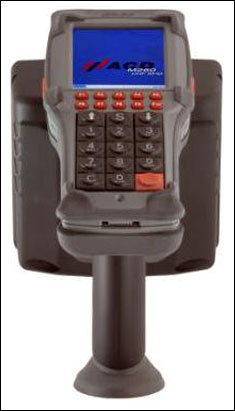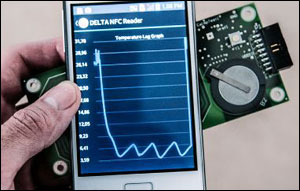The following are news announcements made during the past week by the following organizations:
Kathrein RFID, ACD Group;
AutoCrib;
LogiTag Systems;
Delta Microelectronics;
SimplyRFID; and
Aurnhammer.
Kathrein RFID Announces Beam-Switching UHF Reader Antenna, Handheld UHF Reader
German RFID company Kathrein RFID has announced new antennas for its family of ultrahigh-frequency (UHF) EPC Gen 2 and ISO 18000-6C family of antennas and readers that support the Kathrein RFID Antenna Interface (KRAI). KRAI is designed to improve read rates while reducing hardware costs, particularly within dense transponder populations or in highly reflective environments (see RFID News Roundup: Kathrein RFID Unveils UHF Reader System With Dynamically Adjustable Antenna Polarization). Leveraging specialized antenna-integrated phase shifters that allow static or dynamic adjustment of the circular polarization, KRAI consists of a digital control bus that enables connection between an RFID reader and antennas, in order to allow control and regulation tasks within remote antennas. KRAI commands are transmitted over a standard antenna cable, so no additional lead or connection is required to control the new antenna types. The latest antenna model, the WIRA-30-CSB-KRAI ETSI, is a wide-range antenna with switchable reading zones. The integrated phased array antenna is available for three different reading zones, which are shifted 35 degrees from each other. By recording the moving-behavior of the relevant transponder through the different reading zones, the system can detect their direction. It has an IP 65 rating (meaning that testing has confirmed it to be dustproof and waterproof), and measures 555 millimeters by 262 millimeters by 59 millimeters (22 inches by 10.3 inches by 2.3 inches). The antenna is well suited as an identification system for logistics and electronic article surveillance (EAS) applications, according to Kathrein RFID. The company has also announced a partnership with ACD Group regarding a handheld EPC Gen 2 UHF reader for multiple application scenarios. The M260 transmits and receives with a power of 500mW, Kathrein RFID reports, and is equipped with a patented X-Pol antenna design that provides a reading range of up to 7 meters (23 feet). According to the company, an integrated transponder search function lets users easily search stock and conduct inventories. The mobile unit leverages Microsoft‘s Windows Embedded CE 6.0 operating system, has a long battery life and features an integrated acceleration sensor so it can react to any situation by, for example, quickly saving data prior to an impact, or automatically switching off the display to save valuable energy. At close range, the M260 communicates via a wireless local area network (WLAN), at far range via UMTS or GPRS. All standard data-matrix and bar codes are read at close and far ranges, as are passive EPC Gen 2 RFID transponders, according to Kathrein RFID. The unit is housed in gray impact-resistant ABS plastic, and the quick-entry keyboard can also be operated while wearing work gloves (additional functional keys on the keyboard can be configured as desired). The M260 measures 224 millimeters by 85 millimeters and 47 millimeters (8.9 inches by 3.3 inches by 1.9 inches) and weighs 500 grams (17.6 ounces), with a 7.4-volt rechargeable lithium ion battery.
AutoCrib Unveils New RFID Portal for Smaller Environments
AutoCrib has unveiled the IntelliPort Lite, the company’s latest RFID portal. A less expensive and smaller version of the company’s traditional IntelliPort product, IntelliPort Lite is designed as an RFID-enabled gateway well suited for manufacturing companies, fabricators, machine shops, airlines, distributors and others that want to record the movements of an unlimited number of items from supply rooms or tool cribs but require an RFID portal with a smaller footprint, AutoCrib reports. Enhancements were made to the portal in order to offer a cost-effective product in a smaller footprint. According to the company, the initial of the cost of IntelliPort Lite, which retails for about $22,000, is significantly less than that of AutoCrib’s standard IntelliPort model, which retails for around $35,000. The IntelliPort Lite is available in single- or double-door versions, and can be constructed to work around an existing doorway. This enhancement, AutoCrib explains, enables the machine to be installed without additional construction or modification required to a customer’s building. IntelliPort Lite utilizes an Impinj Speedway Revolution RFID reader and ships with Motorola Solutions RFID antennas. IntelliPort Lite is easy to use, the company reports, and requires virtually no end-user training. Authorized employees can gain access via the locked gates of the IntelliPort Lite gateway using their employee badge or number, and can then freely select needed items. The gateway has a checkout system that, with the push of a button, automatically scans RFID tags attached to items, issues a receipt and unlocks the doors for exit. The portal also includes a returns process that senses and tracks items being returned and unlocks the doors once the scanners confirm that no items are in hand. All of the data is stored in the IntelliPort Lite system for tracking and reporting, AutoCrib reports; operations and procurement managers can use the data captured in IntelliPort Lite to track supply, set inventory alerts and send e-mail reports to any smartphone, tablet or computer. IntelliPort Lite works with the company’s full line of automated inventory vending devices, or can be used as a standalone system.
Bnai Zion Medical Center Expands LogiTag RFID Solution for Automatically Tracking, Reordering Stock
LogiTag Systems has announced an expansion of its StockBox RFID solution at the Bnai Zion Medical Center, a public hospital in Israel with 450 beds that receives more than 65,000 visits to its emergency room and performs about 14,000 surgeries annually. StockBox, a cloud-based RFID solution that leverages 13.56 MHz passive RFID tags compliant with the ISO 15693 standard, had been selected by Israeli medical supplier Sarel to establish a direct communication between Sarel and the hospital, and to enable all reordering information (including restocking reports and requests) to be automatically sent both to the hospital’s enterprise resource planning (ERP) system and to Sarel. StockBox was initially introduced and tested in only one unit, with an average of 44 beds at the hospital. The expansion will more than triple this number, according to LogiTag. StockBox is designed for surgical supplies and other consumables that are only used once. Once a predetermined amount of product is consumed, an RFID tag is placed within an RFID-enabled box, thereby triggering the reordering of that item from the warehouse or stockroom. According to LogiTag, the Bnai Zion Medical Center wanted to reduce the number of out-of-stock situations and ensure ongoing inventory availability for medical personnel at all times. At the same time, LogiTag notes, the facility sought to free up valuable storage space. Sarel can now receive continuous online reports of inventory status, and no longer must wait for hospital personnel to count supplies or send unwanted inventory. The data is available on LogiTag’s Cloud Server solution, according to LogiTag, and is accessible by various departments, including billing, operations and curriers. The hospital plans to expand StockBox’s usage for the entire facility, and to move the entire materials-management responsibility to Sarel.
Delta Microelectronics Intros Evaluation Kit for NFC Data-Logging Chip With Temperature Sensor
Delta Microelectronics, a business unit of Delta Danish Electronics, Light & Acoustics has announced the THOR Evaluation Kit for testing the company’s Near Field Communication (NFC) Thor chip, an ISO 14443A (NFC Type 2) transponder chip (PICC) designed to perform temperature measurements and store results with a configurable time interval (0.1 s to 10 h). The logging capacity is up to 28 kilobytes. The chip has a credit-card-size antenna and a read range of up to 10 centimeters (3.9 inches). Tamper detection is also supported, and DES hardware encryption is available for data privacy. The evaluation kit includes a single tag with the Thor NFC chip mounted on PCB with an antenna and battery, an RFID reader with a USB interface, and a USB memory stick containing an installation manual, an NFC reader app for Android operating systems and a Microsoft Windows graphical user interface (GUI) tool for logging set-up and readouts, as well as a USB cord. Available now, the THOR Evaluation Kit costs $1,385 (€1,000).
SimplyRFID Launches New Site Featuring UHF RFID Surveillance Solution
RFID systems provider SimplyRFID has announced a new surveillance and asset-tracking website, StingKit.com. The site is designed to provide a variety of educational information regarding how to plan for and implement RFID, as well as specifications on all of the company’s hardware and tags, and contact and sales information. Specifically, the site features specs and brochures about the different components of SimplyRFID’s Sting Kit, a plug-and-play RFID and video-surveillance solution that reveals, on a facility map, the real-time movements of individuals and assets. The kit supports ultrahigh-frequency (UHF) EPC Gen 2 RFID and includes SimplyRFID’s Nox software, developed in-house, that comes pre-installed on a notebook PC. In addition, the kit includes an Impinj Speedway Revolution R220 RFID reader; two Laird Technologies RFID antennas; a high-definition IP camera; 100 Nox-3 synthetic Gen 2 pre-programmed RFID tags for off-metal applications, 10 Nox-TM4 rugged metal-mount Gen 2 RFID tags; a sample variety pack of printable EPC Gen 2 RFID labels and rugged EPC Gen 2 tags; one to two days of training at the SimplyRFID facility in Warrenton, Virginia; and premium support and upgrades for 90 days. The Sting Kit is available now for $4,800.
Aurnhammer Organizes BeaconCrawl Event With Manhattan Bars
Aurnhammer, a digital design and development team in New York City, has announced BeaconCrawl, an interactive bar-crawl event that leverages a mobile application and beacons—battery-powered tags that transmit a unique ID number to nearby devices via the Bluetooth Low Energy (BLE) protocol. Various makes and models of Bluetooth beacons will be installed in several venues in lower Manhattan, as well as along the pathway of the bar crawl, according to Donn Gobin, Aurnhammer’s COO. An iOS application will be available at Apple‘s AppStore on or around May 2 (the official date is up to Apple, Gobin explains), and will provide bar crawlers with an invitation and specific details about the event. Aurnhammer is developing an app for Android devices as well, though a release date has not yet been specified. Gobin says the BeaconCrawl—which is designed to showcase how clients can use beacons and apps for interactive marketing and advertising—will be much like a scavenger hunt. As participants move along the path or enter venues, the beacons will emit data that will be picked up by the smartphones, which will then serve up alerts, deals and interactive games, as well as clues for the next stop along the crawl. There will be multiple beacons at each venue, the company reports, and those positioned near venue entrances will serve up information as patrons enter. Beacons are starting to appear in a variety live events. For example, Qualcomm‘s Gimbal Proximity Beacons were used in conjunction with the Tribeca Film Festival‘s official 2014 festival application (see RFID News Roundup: Qualcomm’s Gimbal Beacon Featured at Tribeca Film Festival>).



